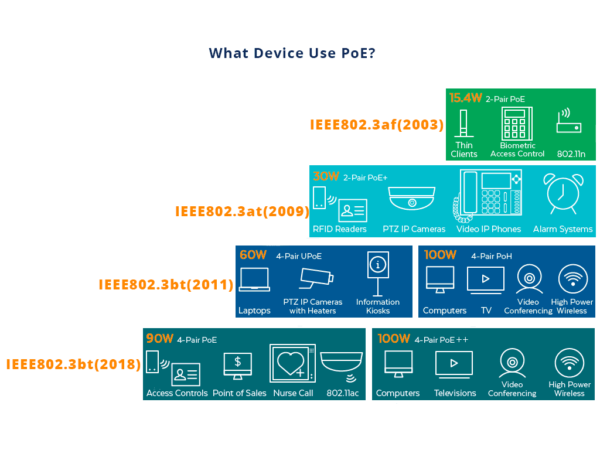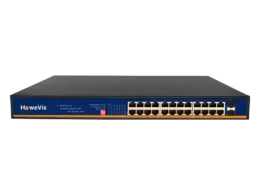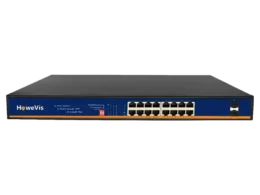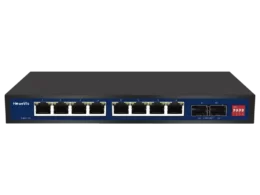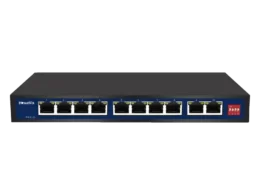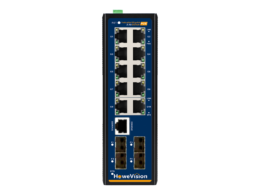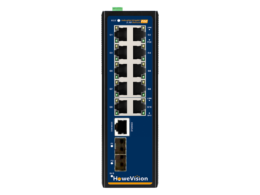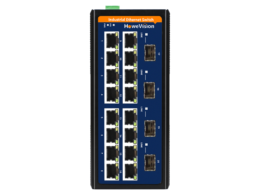Introduction:
The Power over Ethernet is a technology that enables the network cables to carry the Power. These network cables carry Power and data to the devices. These devices connect to the wires. The Power over Ethernet saves the hustle of having two separate lines.
For Example, An Internet Protocol Camera requires a supply of Power and a cable to transfer the data. PoE switch moves Power and data over a single line possible.
Power over Ethernet Switch
Power over Ethernet switch is an application of Power over Ethernet technology.
The Power over an ethernet switch is a switch. That possesses the functionality of Power over the Ethernet built into it. The Power over Ethernet switches has access to the Power over Ethernet. Power Ethernet switches take Power from the central source. And then pass the Power to the other devices connected to them.
Power over Ethernet is valuable for those devices that need Power and send the data as well. The Power over the ethernet switch can connect the devices to a central system. At the same time, the devices are in remote locations.
The essential use of Power over Ethernet is the forming of a network. It connects the devices over one network.
For Example, The Internet Protocol Cameras use Power over Ethernet switches. These help the IP Cameras to switch to different locations. At the same time, they still connect to the one central system. The PoE switches allow the flow of power and data to these Internet Protocol cameras.
Difference between a normal switch and a Power over Ethernet Switch
The most significant difference between a standard switch and PoE is one main difference. The normal switch does not supply power and data at the same time over the cable. The standard switch can only either send data to the end devices or transfer the power supply. It would be best to use the Power over Ethernet if you had a PSE (Power Sourcing Equipment) and a PD (Powered Device). The PoE only needs one network cable to connect the Powered Devices and a power cable for the switch. The mentioned technique makes the PD connected to the PoE gigabit switch port for power and data transmission flow. But, the standard switch needs different cables for supply and Power.
How to convert a normal switch to a PoE switch
The difference between a standard switch and a PoE switch is that the regular switches are not PoE-enabled to transfer data and power. But the standard switch can convert into the PoE switch. Such as the Power over Ethernet can supply the Power and send the data. The data flows through the PoE Splitter and Power over Ethernet Injector.
For Example, An Internet Protocol Camera does not have Power over the switch. It can convert the standard switch into Power over an ethernet-enabled switch. With the PoE injectors‘ help, you can send the data and the Power through the ethernet cable. The data passes between the injector and the Internet Protocol Camera. The data is transmitted from the switch to the injector. The injector then directs the data flow to the IP camera through two wires in the ethernet cable.
The devices use the PoE switches to ditch the hustle of cables and wires, t. The Power over Ethernet switches save the cost. They cut the cost of extra cables and wires. And also, the installation costs and the equipment needed for the electrical installation.
The power ethernet switches also allow the remote placement of the devices. These devices connect to one switch. This one switch is easy to move to a different location without cutting the Power. The example of IP cameras is relevant here, as they are on the high roofs or the rooms’ ceilings.
The Power over Ethernet switches also help save electricity. These switches detect the amount of electricity the PoE-enabled devices need to operate. And then it only supplies the amount detected. The mentioned procedure saves the cost of electricity and allows businesses to save on electricity.
Devices that use Power over Ethernet
The devices that use Power over Ethernet switches are as follows:
Ethernet Extenders
It is a kit that helps network administrators extend a network to a limit beyond the standard 100 meters. The ethernet extender uses an Rj11 line to develop the Ethernet connections. The Rj11 helps to establish lightning-fast network connections between far-fetched locations. The Ethernet can extend the range up to 6000 meters with the help of this device.
Security Access Controls
To shelter a premise, establishments install security access control systems. These depend on user IDs, access cards, and reports to track members of staff. Security Access Control devices connect to your access control system through standard Ethernet cables – which send Power. In a PoE setup, a DC flows through the network cable along with common Ethernet data.
Smart Clocks
Smart clocks enable you to have perfect synchronized times on all clocks. Smart clocks use PoE to receive precise times from your local area network. Or vast area network using Ethernet cable.
Wireless Access Points
Wireless Access Points (WAPs) enable Wi-Fi devices to access a wired network. They make wireless local-area networks (WLANs). The access point is a system that acts as a receiver of wireless radio signals and a central transmitter.
PoS Kiosks
Retailers and other businesses carry out sales. And inventory tracking and recording sales data using Point of Sale (POS) kiosk systems. PoS kiosks use Power over Ethernet to send data and flow Power for the efficient and smooth functionality of the point of sales kiosk. A few examples include electronic cash records, digitalized check-out systems, and self-serve kiosks.
Industrial Control
The use of industrial control systems is in the instrumentation of industrial process mechanisms. These systems can vary in extent. From only a few modular controllers to enormous connections. And interactive distribution control systems. That too with hundreds of field connections. Industrial control systems are most useful in chemical processing, paper production, energy generation, oil and gas extraction, and telecommunications.
Network Switches
The network switch is hardware that helps to connect devices to a computer to share data. It uses packet switching to get and send data to desired devices. Network switches are the most common part of Ethernet-based networks.
VoIP Phones
The VoIP phone requires the flow of data over the network and the supply of Power as well. The Power over Ethernet transmits both of these through a single cable. Through a router, electrical current flows into an ethernet cable. The current flows to the Power over Ethernet switch the phone switches on.
Remote Computer Terminals
The remote computer terminals use the PoE switches to Power themselves. At the same time, they allow the transmission of the data over them too. A single terminal helps operate many computers.
Thin Clients
The thin client is the computers that do not need the operating system to work or do not have the internal disk. The thin clients download the operating system by connecting to a server. The thin clients do not need a high consumption of Power like the other standard computers. Thin clients use the Power over Ethernet switches to carry out these tasks.
Internet Protocol Cameras
An IP camera is a digital camera used for surveillance purposes. An IP camera is different from Closed-Circuit cameras because they need a local recording device. An IP camera connects to a local area network via Power over Ethernet.
LED Lighting Systems
The light-emitting Diode lighting system is a network based on an intelligent control system. It is also known as intelligent lighting. PoE powers an LED lighting system. PoE enables you to have more control over your light quality, energy usage, and LED life. PoE lighting uses Ethernet cables to send data and power lights.
Limitation of Power Over Ethernet Switches That Leads to Limitations for PoE Devices
There are certain limitations of the Power over Ethernet switches. These limitations lead to the ultimate limit of the Power over ethernet-enabled devices.
The first limitation is that the PoE switch can only send the data to the most distance of 100 meters. The mentioned creates a problem for large networks such as networks of campuses, and hotels. This distance increases to 4000 feet through the Power over the ethernet extender.
The other limitation is that the devices need a splitter or an injector. These are to connect to the switch if they are not Power over Ethernet enabled.
The third limitation is that the Power over Ethernet switches when running many devices at one time. They can run out of power because the power load increases from the power budget they have.
